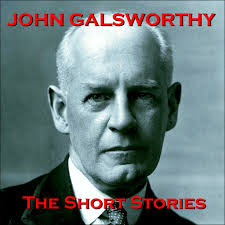
John Galsworthy
John Galsworthy (1867–1933) was a highly influential English novelist and playwright, who was known for his keen interest in studying social subjects and class differences. His work invariably portrayed how industrial changes had affected individual lives, especially at the turn of the 20th century. In the novel “Quality,” Galsworthy demonstrates how old craftsmen are affected by industrialization and how integrity and artistry should never be compromised. His story echoes his profound appreciation for craftsmanship and human connections forged in work, themes that run through a lot of his literary works, including his highly-acclaimed “The Forsyte Saga”.
In this story, Mr. Gessler and his elder brother are traditional shoemakers who make excellent shoes using general leather. They are either German immigrants or Englishmen of German origin. They consider their profession to be an art where they employ no duplicity and they are entirely devoted to their sacred vocation. They also exemplify the essential values of dedication and commitment in shoe-making. Yet, their struggle ultimately ends in a failure, which brings about their untimely death in the most pathetic fashion. John Galsworthy explores this agonising theme in his exceptionally crafty short story ‘Quality’.
Mr. Gessler and his brother are primarily known for using quality material for their products. They never compromise despite being in abject poverty. They do not keep shoes that are not made by them and employ no means of advertisement to enhance their business.The two little shops combined into one, has a small signboard only with the name ‘Gessler Brothers’ printed on it. The narrator wonders about the secret of their trade. Their boots seem to him mysterious and wonderful.
Mr. Gessler’s artistic way of making shoes is truly worthy of appreciation. It looks as if he observes the ‘Soul of Boot’ and analysis thoroughly. He shares a deep bond with his shoes and invests great care to make them perfect. Every shoe crafted by him bears ‘a spirit of the footgear’. Unable to comprehend the mystery behind their art, the narrator asks him, “Isn’t it awfully hard to do, Mr. Gessler?”, to which he replies confidently: “Id is an Ardt!”
His art provides him with a sense of satisfaction. His shoes are tough and last ‘terribly long.’ The narrator himself is surprised when he orders several pairs and they last ‘more terribly than ever.’ He even says, “I was not able conscientiously to go to him for nearly two years”. Unlike any professional, he even goes to the extent of offering the narrator his money back when he complains about the creaking pair of town-walking boots. Mr. Gessler promptly says, “Zome boods are bad from birdt. If I can do nodting wid dem, I take dem off your bill.”
Mr. Gessler makes only a few boots, but all are carefully designed and diligently stitched. He first observes the model and then takes precise measurements by drawing and redrawing. This displays the quality of rare human nature. Though the brothers leave no stone unturned to make their boots the finest ones, they are miserable failures in fighting the hardships of their trade, aware of the growing marketing strategies of the unskilled workers, Mr. Gessler says with a sharp tone of regret: “Dey ged id all. Dey ged id by advertisement, nod by work. Dey dake id away from us, who lofe our boods….”
Things change for the worse for the Gessler brothers. Their policies and strategies, their techniques, their manners become outdated in the fast-paced world. They take much time before delivering their orders, and in this way, they lose all their customers. Though their art, their workmanship, and their products are far better than the rest, they fail to survive because of their orthodox and rigid approach. The tough competition compels them to yield to the prospects of commercial materialism. Their business dwindles, and the elder brother dies, unable to overcome the pain of having lost one of the two shops. Mr. Gessler follows suit and succumbs to the fast-changing times of mass production in the industrial age, and their artistic pursuit remains unrewarded.
The narrator gets to know about the unfortunate death of Mr. Gessler when he visits the shop the last time. An Englishman greets him with a pleasing face and bluntly says that Mr. Gessler finally had to give him owing to his traditional techniques. He explains that people do not wait in the age of changing times. He never believed in the golden policy of advertising his trade, as a result of which he faded away owing to his limitations.
His words make the narrator realise, the inevitability of fate. He understands how their artistic sojourn remain unfinished. Though they retain complete faith in their work, their seemingly excellent craftsmanship suffers a mortal blow in the new age of technological advancements. Their untimely death symbolises the death of art and workmanship. It emphasises the shallow artificiality pervading the modern world, where a person with morals and values is ultimately defeated due to lack of resources. Their harsh lives evoke sympathetic pathos in the narrator, who remains a mute witness to the defeat of the superior to the inferior.
The conclusion turns to the theme of devotion to craft and the practical effect that industrialization brings to skilled labor. The tale does not end well, as the passionate shoemaker, Mr. Gessler, cannot manage to beat mass production for its sheer volume as well as for the new techniques in advertising. Though his art is flawless, it can never keep up with the racing speed and commercial demands of a changing world. Despite that level of craftsmanship and unwavering dedication, he succumbs to poverty and eventually gets run out of business. It is through Galsworthy’s story that one ends up admiring Mr. Gessler’s skill but somehow carrying a desperate sorrow for losing quality to quantity. It’s a poignant reminder of the sacrifices made by artists for the art itself, reflecting on how progress sometimes pushes aside the very spirit and skill that once defined true craftsmanship.
By: Ishita Adhikary
Write and Win: Participate in Creative writing Contest & International Essay Contest and win fabulous prizes.


